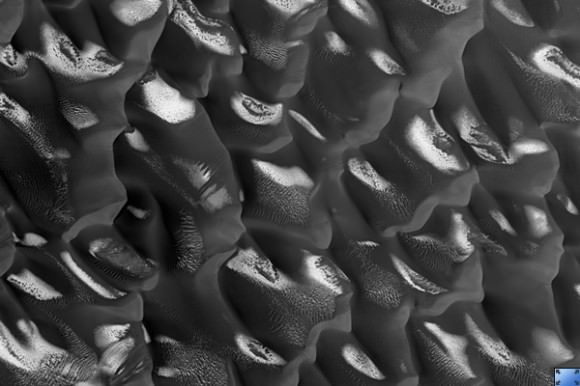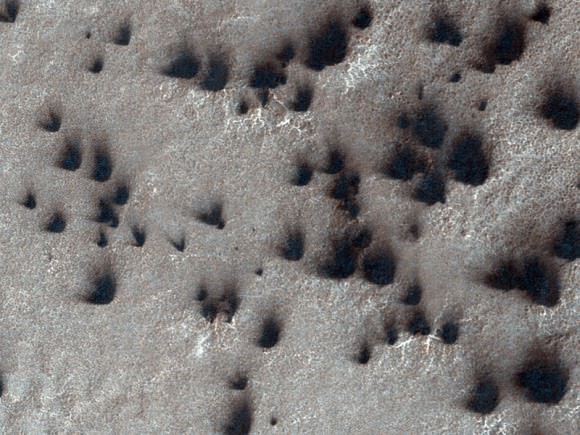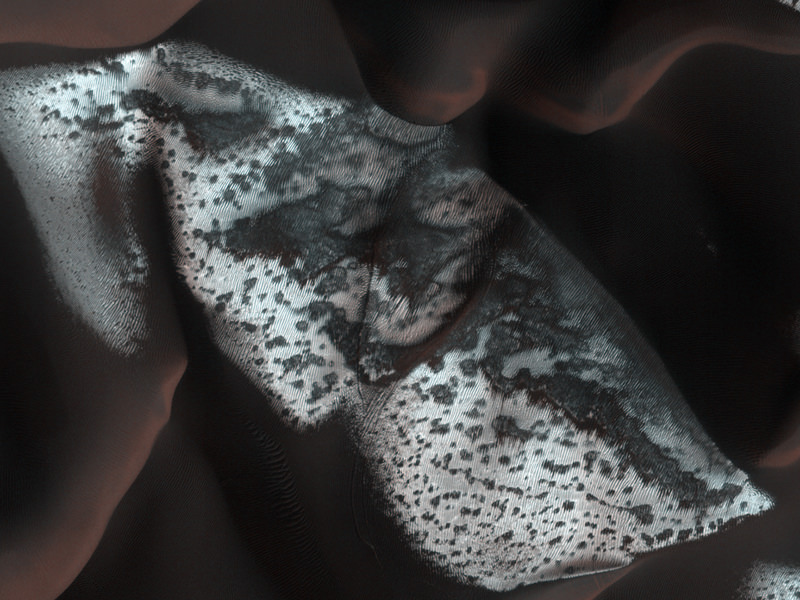[/caption]
If you’ve never seen the “Springtime on Mars 2020” video, its a fun (if not Wall-E-ish) view of what Mars could be like sometime in the future. But now in 2009, winter is turning to spring in Mars’ southern hemisphere, and the HiRISE camera on board the Mars Reconnaissance Orbiter is busy snapping high resolution images of planet’s surface. In the winter the dunes shown here in Proctor Crater are covered with seasonal carbon dioxide frost (dry ice). In the spring, the frost gradually evaporates but lingers in protected regions. In this color image bright ice deposits in sheltered areas highlight the ripples on the dunes. Now that MRO has been in orbit for two Martian winters, this image of Proctor Crater can be compared with the images of these dunes that were taken during the first year of MRO’s mission. Scientists are comparing the images to study inter-annual variability. See an image from January 2007 of Proctor Crater below, as well as more new images from HiRISE.

Here’s how Proctor Crater looked two years ago (one Martian late winter ago), in January 2007. The crater is located -47.2 degrees latitude, and 33.9 degrees longitude East.

Every southern winter the south polar region of Mars is covered with an approximately 1 meter deep layer of frozen carbon dioxide (dry ice). In the spring, when the sun begins to warm the surface below the translucent ice, gas flow under the ice carries loose dust from the surface up onto the top.
The dust falls to the surface in fans, whose orientation is determined by the direction of the local wind flow. Fans from one source region pointing in multiple directions show how the wind direction has changed. Narrow fans pointing in just one direction are the most recent. Alternatively, the vent from the surface may have re-annealed, such that these fans were formed over a very limited time span.

Not quite so far south, at just -28.4 degrees latitude, is Hellas Basin. The detail of this image is amazing, and even though its not a 3-D image, it almost appears so, because of the depth of the detail.
This image shows part of the floor of an impact crater on the northern rim of the giant Hellas Basin.
Hellas includes the lowest elevations on Mars, and may have once held lakes or seas; layered rock outcrops occur around much of the edge of the basin. At this site, a large impact crater (about 90 kilometers across) was partly filled by layered rocks. These rocks on the crater floor are now eroding and forming strange pits.
Here, the layers are mostly exposed on a steep slope which cuts across much of the image. On this slope, they crop out as rocky stripes, some continuous and others not. The material between the stripes is mostly covered by debris, but some areas of exposed rock are visible. The slope is capped by a thick, continuous layer that armors it against erosion; once this cap is gone, the lower material is removed rapidly, forming the steep slope. At the base of this slope, rocks on the floor of the pit appear bright and heavily fragmented by cracks known as joints.
Great images — keep ’em coming, HiRISE!
For more info see the HiRISE site.


The dark fans that form during the Martian spring – has anyone related these to the dark ring that Slipher observed over 50 years ago around the receding polar cap?
My God – they’re beautiful. HiRISE has done for Mars what Hubble has done for the rest of the universe. Equal portions science and art, yet all the while a full serving of beauty.
> My God – they’re beautiful. HiRISE has done for Mars what Hubble has done for the rest of the universe.
Yes, they are indeed beautiful, but personally I found the 3D images of ESA’s Mars Explorer more revolutionary in the way you describe, and thank to the perspective they offer, they are often more spectacular. Thanks god (err… NASA and ESA) for both!
trux Says:
February 19th, 2009 at 4:06 am
Agreed – they’re not too shabby either! This feast of images is all a bit too decadent, isn’t it? Nah…